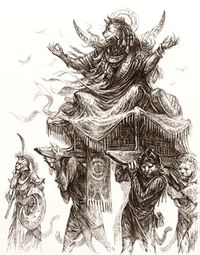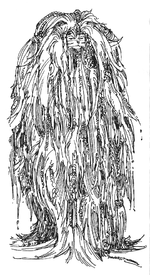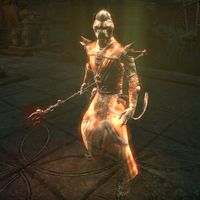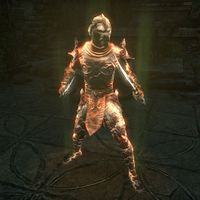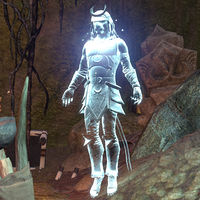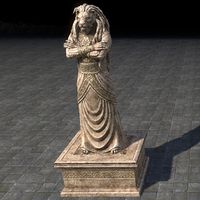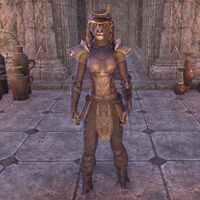Lore:Mane
| This page or section is incomplete. You can help by adding to it. Needs info from Reaper's March questline (i.e., The paths to becoming Mane, more Moon Hallowed lore, etc.) For more information, see the help files, the style guide, and this article's talk page. |
Then shall be born the Mane
Lion Lords and natural leaders
They carry the burden of all
Only one will be chosen
To wear the Crown of Braids
But though forgotten or remembered
Each Mane will forever alter
The Fate of All Khajiit."
—All Our Perfect Forms
The Mane is a unique type of Khajiit. Khajiit tradition holds that only one Mane can be alive at one time and, more specifically, believe that there is actually only one Mane who is reborn again and again in different bodies. There has been no recorded incident of more than one Mane contending for power, although whether due to the truth in the Khajiit belief or whether the ruling Mane takes care of any potential rivals is unknown. Manes can only be born under a rare alignment of the moons Masser and Secunda when, according to legend, a third moon actually appears. In older days the Khajiit would shave off their manes in deference to the Mane, braiding them into locks which the Mane would incorporate into its own mane/headdress.[1] The Mane is so weighted down by the hair that movement is difficult without aid and they often travel the countryside by means of a palanquin. As the population grew, however, this became impractical.[1] As a result, the headdress now only includes hair of the Mane's tribe and Warrior Guard attached to it, which includes several hundred in number.[2]
The Moon Hallowed is a champion blessed by past Manes who arrive in times of peril. They guide the future Manes through their initiation[1] which is known as the Paths. It ends with the final path in the Temple of Two Moons Path, in the city of Dune.[3]
Those born under the sign of the eclipse not chosen to be the Mane would instead be known as Forgotten Manes. Most of these Khajiit would be given to the Pride of Alkosh in Pridehome and be raised as warriors, ready to serve Elsweyr and Alkosh in times of great need.[4][5] In 2E582, a Forgotten Mane by the name of Ra'khajin left the temple in order to serve the dragon Laatvulon as his Dragon Priest, and would later return to raze his former home to the ground. [6]
Those born under the eclipse are more subjectable to the moons, and thus the Dark Moon. The Dark Heart consequently calls to them to the Bent Dance that threatens to turn them to dro-m'Athra, as with the case of the Forgotten Mane Ja'darri,[7] who managed to ward off the corruption.[8] Others are unsuccessful, with the Dark Mane being a prime example. He listened "too much to the Darks", and thus his soul was claimed by Namiira.[9] Tainted, he was no longer fit to lead the Khajiit as a spiritual leader, and was "cast out of the Moon's light, to walk forever in darkness."[10]
Previous Manes[edit]
- Tullar-dra: Unspecified. Reigned in ancient times when the Golden Claw was established as a holy relic in Do'Krin Monastery.[11]
- Jinninji-ri: ~1E 2902 [12]
- Zebiden-jo: ~2E 182 [12]
- Rid-Thar-ri'Datta, the First Mane of Elsweyr: ~2E 309 [2][13]
- Dark Mane: Unspecified. Reigned in ancient times over the Khajiiti people until he fell into the Bent Dance.[10]
- Akkhuz-ri: 2E 582 [10]
- The Lunar Champion: 2E 582 [nb 1]
- Nhad-hatta: ~2E 864 [2]
Forgotten Manes[edit]
Notes[edit]
Gallery[edit]
References[edit]
- ^ a b c Khali's dialogue in ESO
- ^ a b c Pocket Guide to the Empire, 1st Edition: The Elsweyr Confederacy — Imperial Geographical Society, 2E 864
- ^ Kauzanabi-jo's dialogue in ESO
- ^ The Pride of Alkosh — Clan Mother Hizuni
- ^ Pridehome: A Place Outside Time? — Kaalaleth of the Mages Guild
- ^ The Pride of Alkosh quest in ESO: Dragonhold
- ^ Za'ji's dialogue in ESO: Dragonhold
- ^ Ja'darri's dialogue in ESO: Dragonhold
- ^ Moon Bishop Hunal Answers Your Questions — Moon Bishop Hunal
- ^ a b c Akkhuz-ri's dialogue in ESO
- ^ Azahrr's dialogue in ESO
- ^ a b Shazah's dialogue in ESO
- ^ Pocket Guide to the Empire, 3rd Edition: Sugar and Blood: the Cats of the South — Imperial Geographical Society, 3E 432
|
||||||||||||||||||||||||||||||||||||||||||||||||||||||||
|
||||||||||||||||||||||||||||||||
